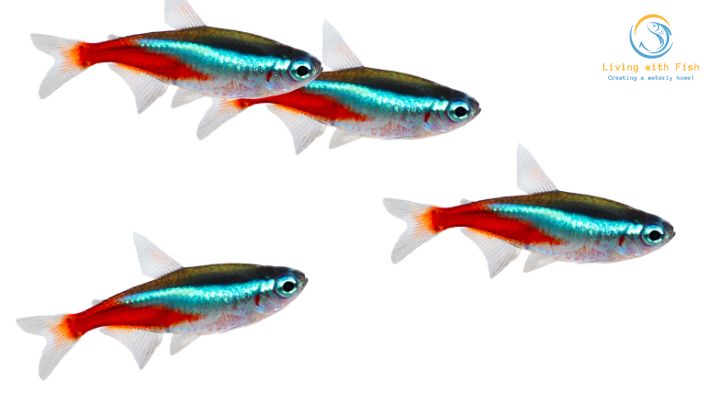This article covers the following areas –
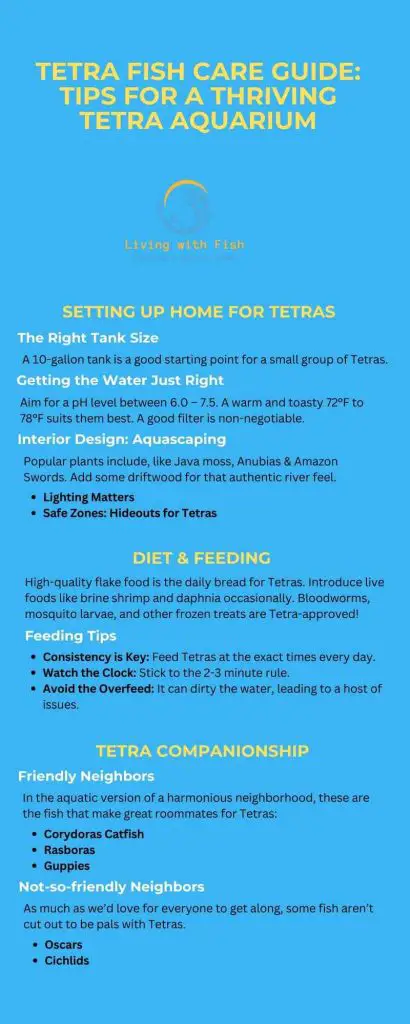
Hey there, fellow aquarist! Tetra fish might be the perfect addition if you’ve considered bringing some vibrant colors and lively energy to your tank. I’ve been keeping Tetras for years, and they have become some of my favorite aquarium buddies. Let me share a few tips and tricks I’ve picked up along the way to help you keep a happy and thriving Tetra community.
Tetras require a stable aquatic environment with a pH of 6.0-7.5, temperatures between 72°F and 78°F, and a diet of flake food, live, and frozen foods. Suitable companions include Corydoras catfish and Rasboras.
To ensure the well-being of your Tetra fish and maintain a thriving aquarium, it’s imperative to delve deeper into their specific care needs. Continue reading for comprehensive insights on tank setup, companionship dynamics, feeding routines, and more.
Getting to Know Tetras
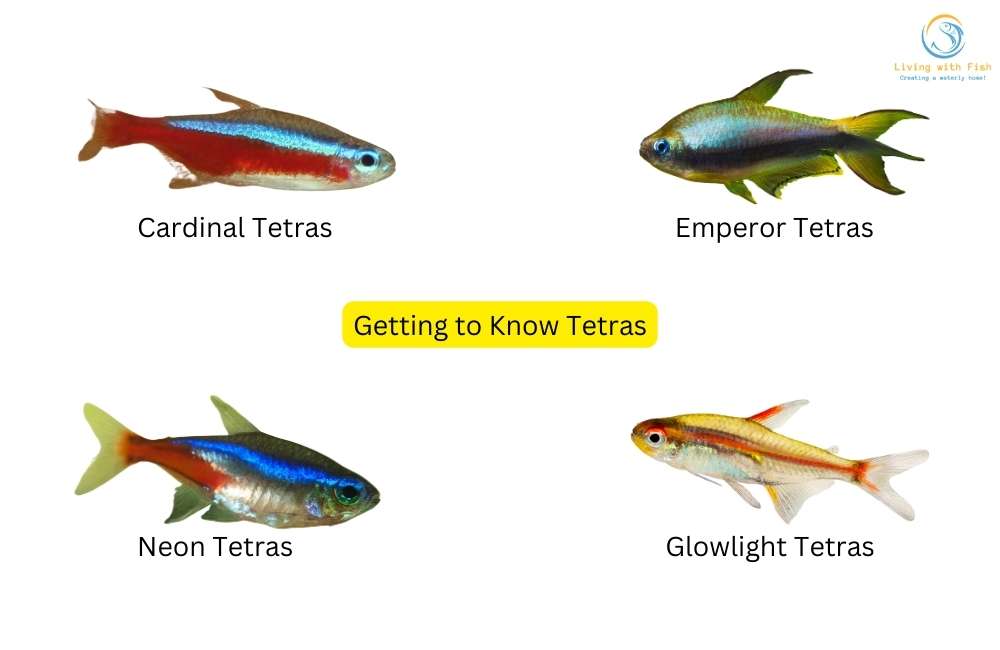
Tetras are pretty cool; trust me on this. They’re beautiful and peaceful, making them an ideal choice for community tanks. There are many species of Tetras, each with unique colors and behaviors. So, let’s get to know them a bit better!
A Splash of History
Originally from South America, Africa, and Central America, these guys have been swimming around our tanks for quite a while. They’ve been popular in the aquarium hobby forever, and it’s easy to see why! Their captivating colors and playful nature have made them a top choice for hobbyists worldwide. When you watch them, you’re not just looking at a fish – you’re peeking into a long history of evolution and adventure.
Different Strokes for Different Folks
While Neon Tetras might be the poster fish for the Tetra family, there are many other cool species to consider:
- Cardinal Tetras: Like Neons, but with a longer red stripe.
- Emperor Tetras: With their royal blue and black colors, they truly are the “emperors” of the Tetra world.
- Glowlight Tetras: These fish sparkle! Enough said.
Tiny Dancers: Understanding Tetra Behavior
Tetras aren’t just pretty; they’re fascinating to observe! They often form schools, and watching them dance synchronously in the water is a treat.
Schooling vs. Shoaling
While many use these terms interchangeably, there’s a subtle difference. Schooling means fish swim in a coordinated manner, while shoaling means they prefer to hang out together. Tetras do both, depending on their mood and environment.
Night-time Antics
Did you know Tetras rest at night? If you peek into your tank when the lights are off, you might see them lying still, only to spring back to life when daylight breaks!
Decoding Tetra Colors
Have you ever wondered why Tetras come in such a riot of colors? Their colors aren’t just for show – they have specific purposes.
Camouflage and Communication
Bright colors can be a form of camouflage in the wild, especially in densely planted areas. They also use their colors to communicate to warn off rivals or attract mates.
Health Indicators
The vibrancy of a Tetra’s color can indicate its health. A pale or discolored Tetra might be stressed or unwell. Always keep an eye on your Tetra’s colors, as it can be their way of telling you something!
I hope this deeper dive gives you a clearer, more vibrant picture of the world of Tetras. These small fish pack a lot of charm, history, and intrigue in their tiny frames. Whether you’re considering getting some or just curious, there’s always something new to learn and appreciate about Tetras.
Setting Up Home for Tetras
Let’s be real: Setting up a new home for your Tetras can be both exhilarating and daunting. After all, these tiny wonders deserve a little haven where they can thrive and dazzle, right? Just as we need our living space to be cozy, comfortable, and reflective of our personality, Tetras, too, have their little quirks and preferences.
The key to their heart (and health) lies in understanding their natural habitat and replicating it, with a dash of your creativity. So, grab your aquarist hat, and let’s embark on this delightful journey of creating a slice of Tetra paradise!
Now, to the fun part! Tetras aren’t too fussy, but they do have some preferences.
The Right Tank Size
While Tetras are small, they love to go to school. And for that, they need space. Imagine wanting to do a dance routine but being stuck in a phone booth. Not fun, right?
- Ideal Tank Size: A 10-gallon tank is a good starting point for a small group of Tetras. This allows them to swim, school, and be playful.
- Going Grand: If you have space and resources, consider larger tanks. Larger tanks allow for a more stable environment and give you the flexibility to add more fish or plants.
Getting the Water Just Right
Tetras, like us with our preferred room temperature, have their sweet spot regarding water conditions.
- pH Levels: Tetras thrive in slightly acidic water. Aim for a pH level between 6.0 – 7.5. Testing kits are readily available, so make it a habit to check regularly.
- Temperature: A warm and toasty 72°F to 78°F suits them best. You might need a heater to maintain this, especially in cooler climates.
- A Note on Filters: A good filter is non-negotiable. It helps keep the water clean, circulates oxygen, and ensures your Tetras breathe easily.
Interior Design: Aquascaping
Now, who doesn’t love a home makeover? Aquascaping is like interior designing for your Tetras.
- Plant Choices: Tetras are used to densely vegetated habitats. Popular plants include:
- Java moss: Easy to grow and maintain.
- Anubias: Hardy and can be attached to rocks or driftwood.
- Amazon Swords: Adds height and depth to your tank.
- Decorative Elements: Add some driftwood for that authentic river feel. Smooth rocks or pebbles can also recreate riverbeds.
Lighting Matters
Tetras are not fans of bright lights. Their natural habitat under dense canopies means they’re used to muted lighting. Consider dimmable LED lights, and maybe throw in some floating plants to diffuse the light.
Safe Zones: Hideouts for Tetras
Despite being active, Tetras appreciate some privacy now and then. Caves, tunnels, or densely planted areas make for great hiding spots. This gives them a sense of security and mimics the nooks and crannies they’re used to in the wild.
There you have it! Crafting the perfect home for Tetras is a blend of science, creativity, and a lot of love. Remember, the more you tune into their needs and natural behaviors, the more you’ll enjoy this rewarding journey. Happy aquascaping!
Diet & Feeding
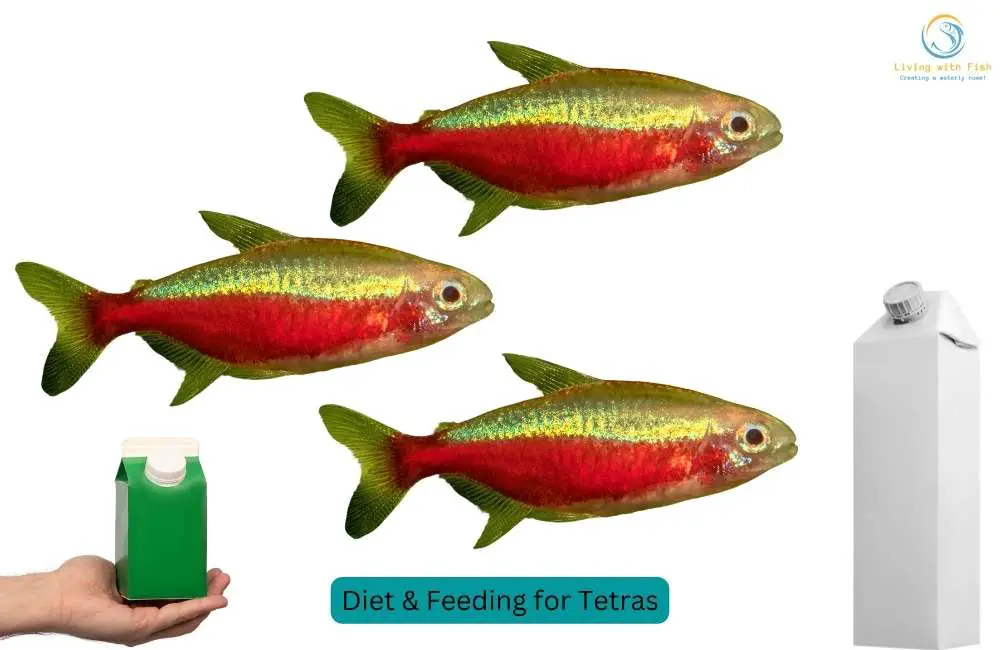
Picture this: a lavish spread of mouth-watering dishes, ranging from your grandma’s secret recipe to a gourmet delicacy from a five-star restaurant. Sounds like a feast, right? Now, if you think you’re the only one who enjoys diverse and scrumptious meals, think again!
Our shimmering Tetra friends, while not picky, absolutely love a rich and varied diet. But here’s the catch – they also need it. As humans benefit from a balanced diet, so do our finned buddies. Let’s deep dive into the Tetra culinary world and discover how to keep their tummies happy and their scales glowing!
Your Tetras are not fussy eaters, but there are some things they love!
What’s on the Menu?
Feeding Tetras isn’t just about filling their bellies; it’s about nutrition, variety, and, sometimes, a little gourmet flair.
- Flake Food: High-quality flake food is the daily bread for Tetras. Packed with essential nutrients, it provides the basics for their diet.
- Live Foods: Introduce live foods like brine shrimp and daphnia occasionally. This adds variety, gets them excited, and simulates their hunting instincts.
- Frozen Foods: Perfect for days you’re out of live food. Bloodworms, mosquito larvae, and other frozen treats are Tetra-approved!
While this might seem like a lot, remember to mix things up; switching between these options keeps mealtime interesting. Trust me; they’ll swim faster to the top when they know something new to munch!
Feeding Tips
Just as important as what you feed them is how you feed them. Here are some nuggets of wisdom:
- Consistency is Key: Feed your Tetras at the exact times every day. They’re creatures of habit, and this helps regulate their digestive systems.
- Watch the Clock: Stick to the 2-3 minute rule. Whatever they can consume in this time frame is enough. And remember, tiny bellies get full pretty fast!
- Avoid the Overfeed: Overfeeding doesn’t just mean wasting food. It can dirty the water, leading to a host of issues. Plus, a clean home equals happy Tetras.
Observing their Eating Habits
Take some time to observe your Tetras during feeding. If they’re rushing to the food, they’re probably happy with what’s being served. It might be time to switch things up if they seem disinterested or leave food uneaten.
Special Considerations for Baby Tetras
Fry, or baby Tetras, requires special attention. They need smaller, more frequent meals. Consider finely crushed flake food or specialty fry food. Ensuring they get the nutrition they need during this growth phase is crucial.
And there we have it! A gourmet guide to keeping your Tetras well-fed and thriving. Remember, a happy Tetra is nourished, content, and eager for the next mealtime. Happy feeding!
Tetra Companionship
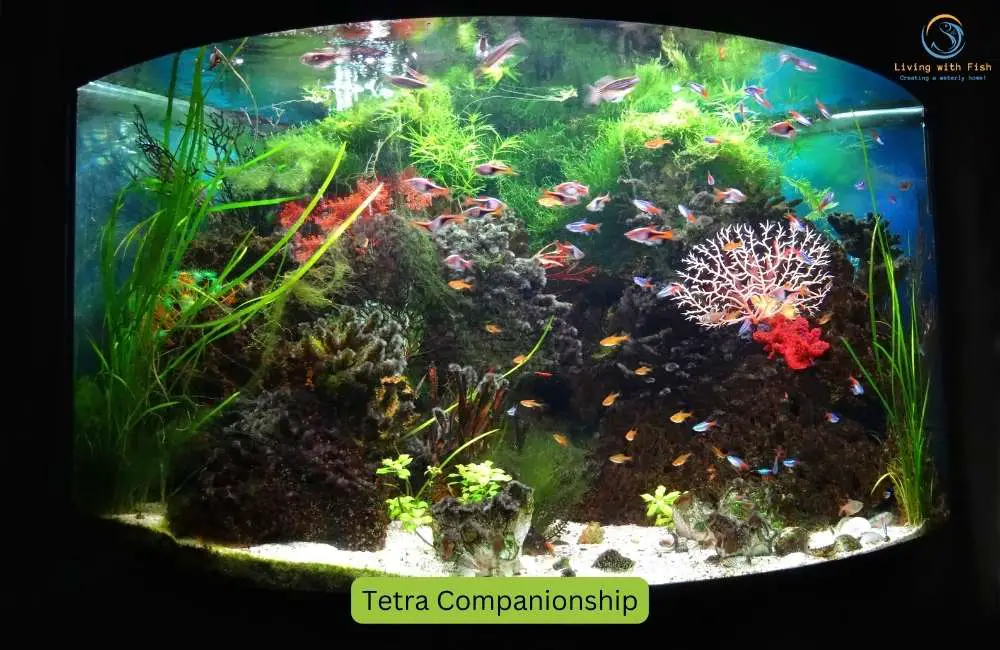
Have you ever shared a room or lived with a bunch of roommates? Then you’ll know how crucial it is to find folks you click with who respect your space, and maybe even become lifelong friends. Fish, believe it or not, are no different! In the watery world of our aquariums, harmony among its inhabitants is vital.
With their gentle nature, Tetras require pals that won’t ruffle their fins (literally and figuratively). So, before you rush to buy new tank mates for your Tetras, let’s understand which fish can be their buddies and which might stir up some underwater drama!
Tetras are like those friends who get along with almost everyone but still have a few buddies they vibe with best.
Friendly Neighbors
In the aquatic version of a harmonious neighborhood, these are the fish that make great roommates for Tetras:
- Corydoras Catfish: They are peaceful and stay mostly at the bottom of the tank, giving your Tetras plenty of swimming room. Plus, they help clean up any leftover food.
- Rasboras: These fish share a similar temperament to Tetras and are often just as colorful and vibrant. They complement each other beautifully in terms of behavior and aesthetics.
- Guppies: With their stunning tails and friendly nature, Guppies co-exist well with Tetras. They’re both active swimmers and often go to school together.
Remember, peaceful neighbors make for a happy tank environment. It’s lovely to see different species swimming together in harmony.
Not-so-friendly Neighbors
As much as we’d love for everyone to get along, some fish aren’t cut out to be pals with Tetras.
- Oscars: These fish might be gorgeous but also quite aggressive. They’re larger and might see your tiny Tetras as a quick snack. A no-go!
- Cichlids: While there are many types of Cichlids, most can be territorial and aggressive. They can easily stress out or even harm your Tetras.
Keeping an Eye Out
Regularly observe the dynamics in your aquarium. Even among “friendly” species, individual personalities can differ. Reconsidering your fishy combinations might be a good idea if you notice any bullying or aggressive behavior.
Mixing Tetra Species
You might wonder about mixing different Tetra species in one tank. In general, various Tetras can coexist. However, remember that some may prefer to attend school with their kind. So, provide enough numbers for each species to form its little school.
In conclusion, the key to a peaceful aquarium lies in careful selection, regular observation, and understanding of each species’s unique personalities and needs. After all, every fish deserves to swim in harmony and have its band of underwater buddies. Here’s to fostering fishy friendships!
Final Thoughts
With their vibrant colors and graceful movements, Tetra fish can truly transform an aquarium into a mesmerizing display of underwater beauty. Ensuring their well-being, however, goes beyond aesthetic considerations.
Every decision impacts their health and happiness, from the initial tank setup to selecting their tank mates and deciding on a nutritious diet. Like any pet, Tetras thrive when their owners understand and cater to their specific needs.
By providing them with the right environment, companionship, and diet, we ensure their longevity and witness the captivating dance of colors and life they bring to our homes. Happy fish-keeping!

